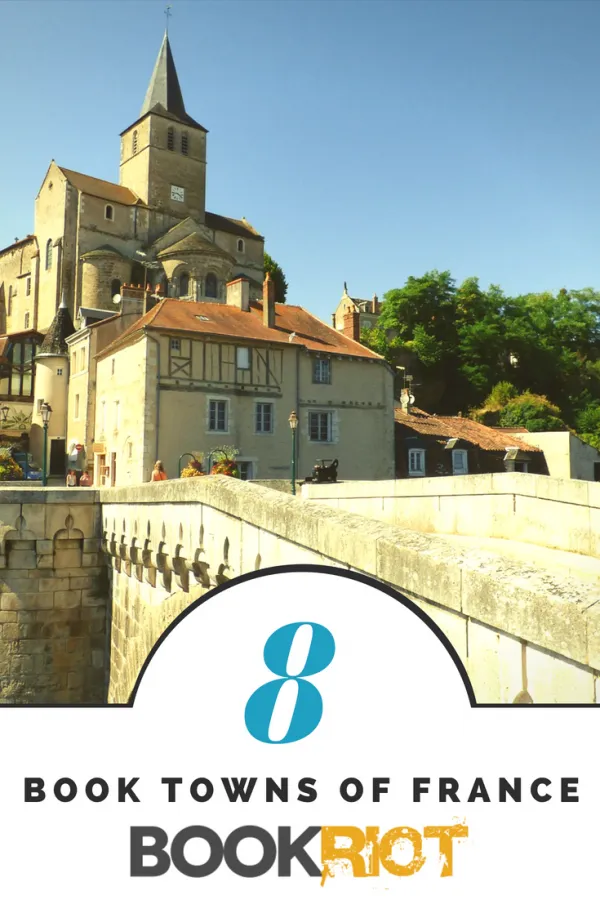
Literary Tourism: The Book Towns of France
This content contains affiliate links. When you buy through these links, we may earn an affiliate commission.
Imagine driving through the picturesque French countryside, observing sheep or vineyards or what have you, when you come across a town that looks like it time traveled right from the middle ages. You get out of your car to explore, expecting a sleepy village. Instead, the narrow streets are bustling, packed with tables piled high with books. Colorful façades of specialized bookstores line the main street, along with art galleries and shops specializing in book crafts. Have you died and gone to bibliophile heaven? No, you’ve managed to land yourself in one of the book towns of France.
 Book towns–communities actively attracting book lovers with a high concentration of bookshops and bookish arts–exist all over the world, from Tokyo’s Jimbochō to Hay-on-Wye in Wales. France has eight book towns, all rural medieval villages full of charm and history, but lacking the industry and opportunity to attract new residents. That is, until they became book towns!
By establishing themselves as book towns, many of these small cities and villages have jump-started their economy and culture. They’re not just centers for bookselling, but homes for artists, artisans, writers, restauranteurs, and gallery owners.
Book towns–communities actively attracting book lovers with a high concentration of bookshops and bookish arts–exist all over the world, from Tokyo’s Jimbochō to Hay-on-Wye in Wales. France has eight book towns, all rural medieval villages full of charm and history, but lacking the industry and opportunity to attract new residents. That is, until they became book towns!
By establishing themselves as book towns, many of these small cities and villages have jump-started their economy and culture. They’re not just centers for bookselling, but homes for artists, artisans, writers, restauranteurs, and gallery owners.
 If you ever visit France, you owe it to yourself as a bibliophile to venture outside the big cities and visit at least one book town. And if you want to learn more about book towns, of France and elsewhere, I recommend Alex Johnson’s Book Towns: Forty-Five Paradises of the Printed Word.
Now on to France’s book towns!
If you ever visit France, you owe it to yourself as a bibliophile to venture outside the big cities and visit at least one book town. And if you want to learn more about book towns, of France and elsewhere, I recommend Alex Johnson’s Book Towns: Forty-Five Paradises of the Printed Word.
Now on to France’s book towns!

 Book towns–communities actively attracting book lovers with a high concentration of bookshops and bookish arts–exist all over the world, from Tokyo’s Jimbochō to Hay-on-Wye in Wales. France has eight book towns, all rural medieval villages full of charm and history, but lacking the industry and opportunity to attract new residents. That is, until they became book towns!
By establishing themselves as book towns, many of these small cities and villages have jump-started their economy and culture. They’re not just centers for bookselling, but homes for artists, artisans, writers, restauranteurs, and gallery owners.
Book towns–communities actively attracting book lovers with a high concentration of bookshops and bookish arts–exist all over the world, from Tokyo’s Jimbochō to Hay-on-Wye in Wales. France has eight book towns, all rural medieval villages full of charm and history, but lacking the industry and opportunity to attract new residents. That is, until they became book towns!
By establishing themselves as book towns, many of these small cities and villages have jump-started their economy and culture. They’re not just centers for bookselling, but homes for artists, artisans, writers, restauranteurs, and gallery owners.
 If you ever visit France, you owe it to yourself as a bibliophile to venture outside the big cities and visit at least one book town. And if you want to learn more about book towns, of France and elsewhere, I recommend Alex Johnson’s Book Towns: Forty-Five Paradises of the Printed Word.
Now on to France’s book towns!
If you ever visit France, you owe it to yourself as a bibliophile to venture outside the big cities and visit at least one book town. And if you want to learn more about book towns, of France and elsewhere, I recommend Alex Johnson’s Book Towns: Forty-Five Paradises of the Printed Word.
Now on to France’s book towns!
Bécherel, Brittany, est. 1988
The oldest–and, according some, most beautiful–book town in France, Bécherel is the perfect example of what transforming into a book town can do for a small, isolated village. Bécherel’s population of 800 enjoys excellent restaurants, cultural events, art galleries, and tourism thanks to numerous literary festivals, bookish exhibits at the Maison du Livre, and more than a dozen bookshops. Some bookstores of note include Neiges d’Antan (a reference to a poem by François Villon), with 40,000 titles covering three floors; Librairie la Chouette, specializing in illustrated books from the 19th and 20th centuries, plus African Art; and Outrepart, which carries scifi, fantasy, utopian (or distopian?), and gothic novels. If you want to see more of Bécherel, you can view this video. https://www.instagram.com/p/Bgyn27fAECo/Montolieu, Languedoc-Roussillon, est. 1989
Ridiculously picturesque, Montolieu is arguably France’s most successful book town. It’s the vision one man–Michel Braibant–who wanted to celebrate not only books, but their production and broader role in arts and culture. Montolieu is famous not only for its dozen-odd bookshops, but for its artists and galleries, plus a world-class fine arts collection that attracts visitors from all over the globe. Also be sure to visit the popular Musée des Arts et Métiers du Livre, where you can walk through exhibits on the history of writing and publishing, or view a demonstration in paper making, printing, and more bookish arts. If you’re feeling lucky, take your copy of Perfume along–you might spot notoriously reclusive author Patrick Süskind and convince him to sign it for you.
Image by Ji-Elle via Wikimedia Commons











